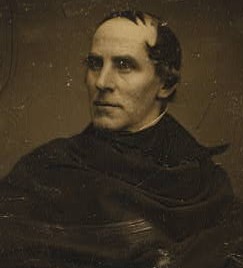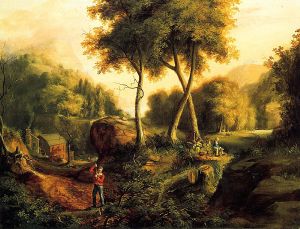Cole, Thomas
David Doose (talk | contribs) (Started) |
|||
| Line 24: | Line 24: | ||
}} | }} | ||
| − | '''Thomas Cole''' (February 1, 1801 - February 11, 1848) was a nineteenth century [[United States|American]] artist; he is regarded as the founder of the [[Hudson River School]], an American [[art]] movement that flourished in the mid-19th century and was concerned with the [[realism|realistic]] and detailed portrayal of [[nature]]. His romanticized depiction of nature inspired other artists at the time and later to depict the inspiration and [[beauty]] of nature, often in a fantastic or allegorical fashion. | + | '''Thomas Cole''' (February 1, 1801 - February 11, 1848) was a nineteenth century [[United States|American]] artist; he is regarded as the founder of the [[Hudson River School]], an American [[art]] movement that flourished in the mid-19th century and was concerned with the [[realism|realistic]] and detailed portrayal of [[nature]]. His romanticized depiction of nature inspired other artists at the time and later to depict the inspiration and [[beauty]] of nature, often in a fantastic or [[allegory|allegorical]] fashion. |
== Early life and education == | == Early life and education == | ||
Revision as of 16:27, 15 December 2007
- Not to be confused with Thomas Cole, a New Zealand mayor or Tom Cole, the Oklahoma representative.
| Thomas Cole | |
 Thomas Cole, ca. 1844-48 | |
| Born | February 1 1801 Bolton, Lancashire, England |
| Died | February 11 1848 (aged 47) Catskill, New York |
| Nationality | English |
| Field | painting |
| Movement | Hudson River School |
| Famous works | |
| Influenced | Asher B. Durand and Frederic Edwin Church |
Thomas Cole (February 1, 1801 - February 11, 1848) was a nineteenth century American artist; he is regarded as the founder of the Hudson River School, an American art movement that flourished in the mid-19th century and was concerned with the realistic and detailed portrayal of nature. His romanticized depiction of nature inspired other artists at the time and later to depict the inspiration and beauty of nature, often in a fantastic or allegorical fashion.
Early life and education
Thomas Cole was born in Bolton, Lancashire, England. In 1818 his family emigrated to the United States, settling in Steubenville, Ohio, where Cole learned the rudiments of his profession from a wandering portrait painter named Stein. However, he had little success painting portraits, and his interest shifted to landscape. Cole moved to Pittsburgh in 1823 and then to Philadelphia in 1824, where he drew from casts at the Pennsylvania Academy of the Fine Arts and exhibited for the first time. [1] The following year, Cole rejoined his parents and sister in New York City.
Painting
In New York he sold three paintings to George W. Bruen, who financed a summer trip to the Hudson Valley where he visited the Catskill Mountain House and painted the ruins of Fort Putnam[1]. Returning to New York he displayed three landscapes in the window of a bookstore, where as recounted in the pages of the New York Evening Post [2] they attracted the attention of the painter John Trumbull, who sought him out, bought one of his canvases, and put him into contact with a number of his aristocratic friends including Robert Gilmor of Baltimore and Daniel Wadsworth of Hartford, who became important patrons of the artist.
In 1826 Cole moved to Catskill, New York where he maintained a studio at the farm called Cedar Grove. He painted a significant portion of his work in this studio, taking in the sights of the WHite Mountains and Niagra. Cole spent the years 1829 to 1832 inEngland and Italy supported by his patron Robert Gilmore of Baltimore. At one point he lived with sculptor Horatio Greenough in Florence. He then returned to New York in 1832 where he begin the five panel series Course of Empire. In 1836 he married Maria Bartow of Catskill, whose family home became their permanent residence. [2]
Cole went to Europe again in 1841, returned home, and visited Mount Desert on the Northeast United States coast. He died at Catskill on February 11, 1848. The fourth highest peak in the Catskills bears his name.[3].
Allegorical Works
Cole was primarily a painter of landscapes, but he also painted allegorical works. The most famous of these are the five-part series, The Course of Empire, now in the collection of the New York Historical Society and the four-part The Voyage of Life. There are two versions of the latter, one at the National Gallery in Washington, D.C., the other at the Munson-Williams-Proctor Arts Institute in Utica, New York. At the time of his death, Cole, a Swedenborgian mystic, was painting the religous allegory Cross of the World.[4]
Architecture work
Cole dabbled in architecture, a not uncommon practice at the time when the profession was not so codified. Cole was an entrant in the design competition held in 1838 to create a new state government building in Columbus, Ohio. His entry won third place, and many contend that the finished building, a composite of the first, second and third place entries, bears a great similarity to Cole's entry.
Legacy
Cole influenced his artistic peers, especially Asher B. Durand and Frederic Edwin Church, who studied with Cole from 1844 to 1846.
Selected works
The Garden of Eden (1828)
- Cole Thomas Evening in Arcady 1843.jpg
Evening in Arcady (1843)
- Cole Thomas Daniel Boone Sitting at the Door of His Cabin on the Great Osage Lake Kentucky 1826.jpg
Daniel Boone Sitting at the Door of His Cabin on the Great Osage Lake Kentucky (1826)
Notes
- ↑ Answers.com Retrieved Dec. 12, 2007
- ↑ Thomas Cole, Biography Resource Center, 1998. Retrieved Dec. 12, 2007.
- ↑ Cedar Grove History
- ↑ Answers.com Retrieved Dec. 12, 2007
ReferencesISBN links support NWE through referral fees
- Baigell, Matthew. Thomas Cole. Watson-Guptill (January 1, 2000). ISBN 0823006476
- Powell, Earl A. 1990. Thomas Cole. New York: H.N. Abrams. ISBN 0810931583
- Miller, Angela. 1993. The Empire of the Eye: Landscape Representation and American Cultural Politics, 1825-1875. New York: Cornell University Press. ISBN 0801428300
- Noble, Louis Legrand, Thomas Cole, and Elliot S. Vesell. 1997. The Life and Works of Thomas Cole. Hensonville, N.Y.: Black Dome Press. ISBN 1883789133
- "Thomas Cole." Encyclopedia of World Biography, 2nd ed. 17 Vols. Gale Research, 1998.
External links
- Cedar Grove - The Thomas Cole National Historical Site in Catskill, NY
- Find-A-Grave profile for Thomas Cole
- Works by Thomas Cole at the Cincinnati Art Museum
This article incorporates text from the Encyclopædia Britannica Eleventh Edition, a publication now in the public domain.
Credits
New World Encyclopedia writers and editors rewrote and completed the Wikipedia article in accordance with New World Encyclopedia standards. This article abides by terms of the Creative Commons CC-by-sa 3.0 License (CC-by-sa), which may be used and disseminated with proper attribution. Credit is due under the terms of this license that can reference both the New World Encyclopedia contributors and the selfless volunteer contributors of the Wikimedia Foundation. To cite this article click here for a list of acceptable citing formats.The history of earlier contributions by wikipedians is accessible to researchers here:
The history of this article since it was imported to New World Encyclopedia:
Note: Some restrictions may apply to use of individual images which are separately licensed.



















